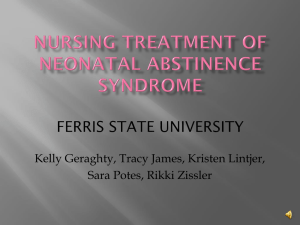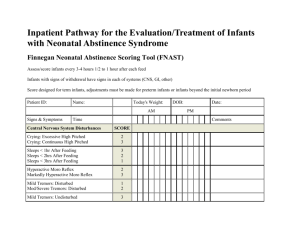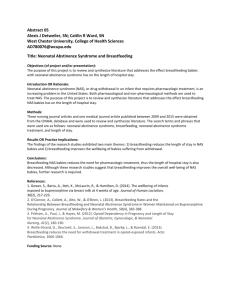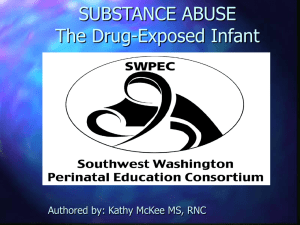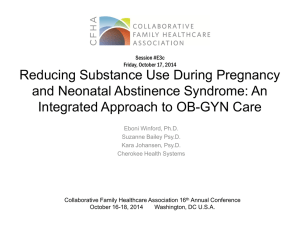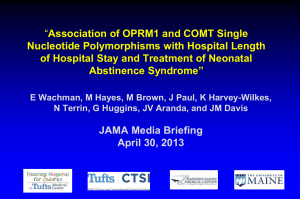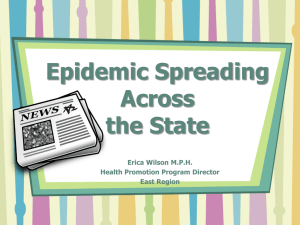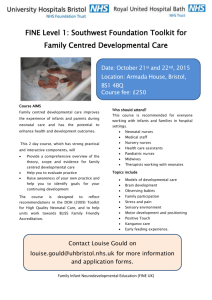Nursing Treatment of Neonatal Abstinence Syndrome Paper
advertisement
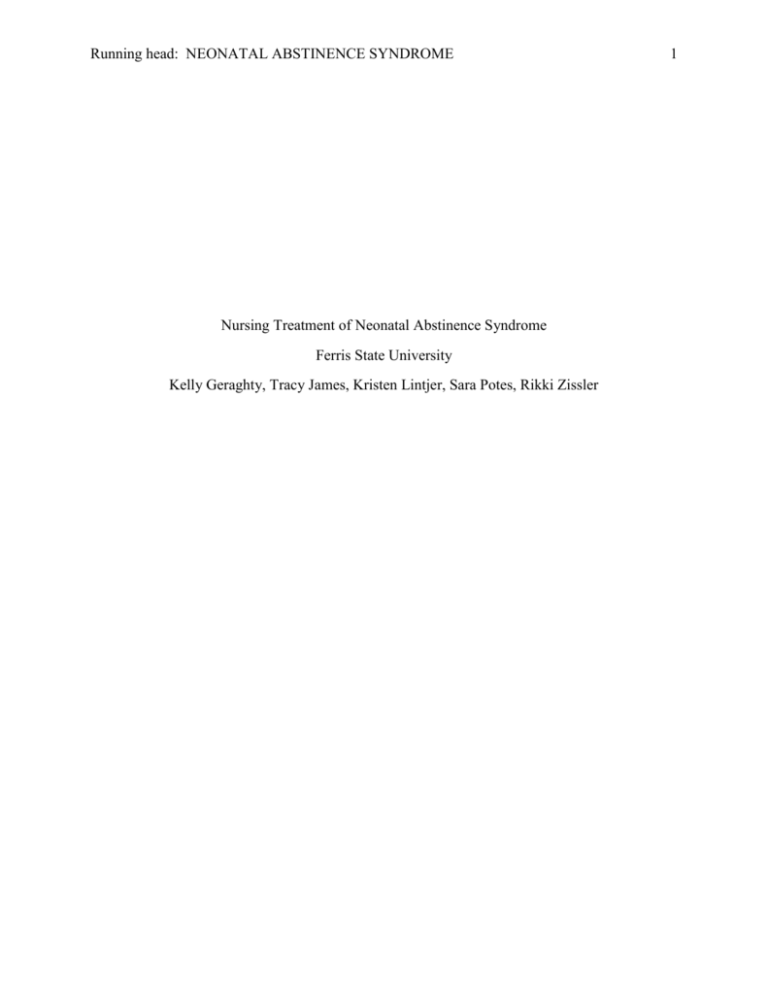
Running head: NEONATAL ABSTINENCE SYNDROME Nursing Treatment of Neonatal Abstinence Syndrome Ferris State University Kelly Geraghty, Tracy James, Kristen Lintjer, Sara Potes, Rikki Zissler 1 NEONATAL ABSTINENCE SYNDROME 2 Abstract The purpose of this paper was to determine the best methods for treating newborn infants that are experiencing neonatal abstinence syndrome (NAS). There are two categories of NAS: NAS due to prenatal or maternal use of substances that result in withdrawal symptoms in the newborn and postnatal NAS secondary to discontinuation of medications such as fentanyl or morphine used for pain therapy in the newborn (Hamdan, 2010). For the purpose of this paper we concentrated on the first category of NAS that of withdrawal due to maternal prenatal drug use. The results of our research concluded that a combination of both is the best method of treatment. If an infant can be treated without the use of medication it shortens hospital stay and is best for follow up. But if an infant has persistent high NAS scores, it is best to also include medical therapy as ordered. NEONATAL ABSTINENCE SYNDROME 3 Drugs that are frequently associated with NAS include heroin, methadone, morphine cocaine, alcohol and nicotine. There has been a recent increase in our area in the amount of babies being born addicted to methadone which has been an approved form of therapy for opiateaddicted pregnant women. The use of methadone has been associated with improvement of prenatal care and obstetric outcomes however can certainly be a cause of NAS. Withdrawal may occur as soon as 48 hours after birth and may appear up to 7-14 days after birth (Hamdan, 2010). Infants are suspected of having NAS if they exhibit any of the following signs: high pitched cry, restlessness with frequent sleep disruption, jitteriness, tremors, hypertonia and generalized convulsions. Other symptoms include sweating, fever, frequent yawning, sneezing and apnea (Hamdan, 2010). These infants also may experience feeding intolerance and failure to thrive. The most widely used system for NAS scoring is the Finnegan scoring system (Hamdan, 2010). This scale assesses 21 of the most common signs of neonatal drug withdrawal syndrome and is scored on the basis of pathological significance and severity of the adverse symptoms (Hamdan, 2010). If an infant receives three consecutive scores of 8 or higher, treatment for withdrawal is started. This treatment consists of pharmaceutical interventions such as morphine and methadone, as well as non-pharmaceutical interventions such as dark, quiet rooms, swaddling, holding, and use of a pacifier. The aim of this paper is to research the most common methods of treatment of NAS to determine the best way to treat so as to aid in the best outcome for the infant and family. Literature Review NEONATAL ABSTINENCE SYNDROME 4 We have five members in this group, all of which work in a Neonatal Intensive Care Unit. This group chose to research the topic of infants with neonatal abstinence syndrome. We searched scholarly literature to answer the PICO question “are newborn infants with high neonatal abstinence syndrome scores (8 or above) more responsive when nurses treat them with pharmaceutical or non-pharmaceutical interventions?” We began by using our PICO question to search for different articles that would relate to our topic. We had some difficulty in the beginning finding the right articles because we needed to be sure that we were focusing on the nursing aspect of our topic and not the medical aspect. We eliminated articles that were too old or that did not contain enough nursing intervention. An article by Oei & Lui (2007), “Management of the newborn affected by maternal opiates and other drugs of dependency”, was not chosen because the study seemed to contain a lot of the same information that we found in other articles and the full PDF was only available in Japanese. The article “Neonatal Drug Withdrawal” contains very pertinent information that continues to be used today, but it was written in 1998. Another article titled “Evidenced Based Care Sheet, Neonatal Abstinence Syndrome” was good, but very short. It summarized what all the articles had already stated. The article "Clonidine as an adjunct therapy to opioids for neonatal abstinence syndrome: a randomized, controlled trial" Agthe, Kim, Mathias, Hendrix, Chavez-Valdez, Jansson, Lewis, Yaster and Gauda (2009) was dismissed. The use of Clonidine is largely a medical intervention and not a nursing one and therefore not included this paper. The article “Treatment of neonatal abstinence syndrome” Johnson, Gerada, and Greenough (2003) was dismissed based on the date of the article. We were able to find more current and relevant articles to use instead of this one. Another article dismissed was written by Jansson, L.M. and Velez, M.(2008) “The neonatal NEONATAL ABSTINENCE SYNDROME 5 withdrawal inventory: A simplified score of neonatal withdrawal.” Although this article was good, it just repeating what we had already learned. The first article used was “Opiate treatment for opiate withdrawal in newborn infants”, Osborn, Jeffery, & Cole (2010). They conducted a study using either random or quasi-random patient allocation. This study was done to “assess the effectiveness and safety of using an opiate compared to a sedative or non-pharmacological treatment for treatment of NAS due to withdrawal from opiates” (Osborn et al., 2007, p. 2). The studies enrolled 645 infants. There were nine studies done. These ranged from opiates versus supportive care to opiates versus phenobarbitone. Withdrawal from heroin usually presents at 24 hours after birth, where infants withdrawing from methadone usually show signs two to seven days after birth. It was found that there was no real difference in the failure of treatment between the infants receiving opiates to those receiving supportive care (Osborn et al., p. 3-4). This study also showed that infants that received opiates along with supportive care had a faster birth weight regain compared to infants that only received supportive care (Osborn et al., p. 8) Another article reviewed was “Neonatal Abstinence Syndrome” by Burgos and Burke (2009). It stated that the treatment of NAS should always begin with non-pharmacologic measures. These measures include gentle handling, ambient noise control, swaddling and an on demand feeding schedule. These interventions should be used in conjunction with pharmacologic measures as called for. The goal of therapy is to allow the infant to withdrawal with a minimal amount of complication. The first intervention includes reducing environmental stimulation. This can be achieved by a quiet room, dim lighting and low activity level. It is best to move the infant away from the NEONATAL ABSTINENCE SYNDROME 6 telephone, sink and other high traffic areas. Nurses should use slow movements and avoid talking at the bedside. Everything for care should be prepared prior to disturbing the infant. Also stimulus should be limited to one at a time (rocking, voice, music, etc.) The infant should be kept swaddled and contained when in sleeping state, and avoid waking from a deep sleep. It is important that the infant with possible NAS have adequate nutrition. Their nutritional needs may be greater than that of a normal newborn due to the stress and activity that comes from withdrawal. Breastfeeding should be encouraged and has been shown to reduce the severity of NAS. A pacifier should be offered or hands for non-nutritive sucking. The infant should be fed on demand with small frequent feedings with rest between sucking. Also physical and occupational therapy may be consulted for more ideas. It is also important to offer emotional support to the family. Mothers will appropriately feel anxiety and guilt, and nurses should be prepared to be empathetic and nonjudgmental. Prenatal counseling as to what the hospitalization will be like for their infant is an important nursing intervention. After the birth, encourage family to do as much care as possible and tell them that support will be available even after discharge from the hospital. The next article reviewed was “Maternal Methadone use in pregnancy factors associated with the development of neonatal abstinence syndrome and implications for healthcare resources” by Dryden, Young, Hepburn and Mactier, 2009. In this article infants born to drugmisusing mothers are recognized to be at risk of preterm delivery, poor intrauterine growth, and development of neonatal abstinence syndrome. Using methadone as a substitute therapy helps to stabilize lifestyle and reduces risk-taking behaviors as well as reducing the incidence of preterm birth and intrauterine growth restrictions, but is commonly associated with NAS. NEONATAL ABSTINENCE SYNDROME 7 There has been some association with increased rate of NAS and longer hospital stay in infants born to mothers with poly-drug use. There is also a correlation between a higher methadone use and decrease amount of poly-drug use which suggests a higher dose of methadone reduces poly-drug use and side effects to the infant. In this study the woman were provided with substitute therapy of methadone and social work services. Standard methadone treatment is to prescribe enough methadone to eliminate physical withdrawal symptoms. NAS was defined as those infants with severe enough signs to require pharmacological interventions. The study included 450 infants and data was collected on 437 (Dryden, et al., 2009). Of the infants in the study, 45.5% of received pharmacological treatment for NAS (Dryden, et al., 2009). Duration of oral morphine was from 1-44 days Dryden, et al., 2009). Half were discharged to home on Phenobarbital and therapy ranged from 2-140 days (Dryden, et.al. 2009). As high as 93% of infants requiring Phenobarbital were exposed to poly-drug use in utero (Dryden, et al., 2009) . Breastfeeding was initiated in 27.7% of these infants and 48.8% of these infants were admitted to the NICU (Dryden, et. al., 2009). Stay ranged from 1-108 days and 40% of these were admitted due to NAS (Dryden, et. al., 2009). Breastfeeding for greater than 48 hours was independently associated with halving the odds of the infant receiving pharmacological treatment for NAS. The act of breastfeeding soothes agitated infants and drugs taken by the mother are excreted in varying amounts in breast milk which reduces the effects of withdrawal. The average rate of drug using mothers who breastfeed is 35% by day 5 (Dryden, et. al., 2009). It is the impression of this study that the majority of drug-misusing mothers, who do not choose to breastfeed, do so because of deeply engrained social prejudice and not because of poly-drug misuse. It is recommended that all drug- NEONATAL ABSTINENCE SYNDROME 8 misusing mothers be encouraged to breastfeed their infants and rooming in helps to facilitate this. The article “Neonatal abstinence syndrome: assessment and pharmacotherapy” Finnegan (1990) describes the neonatal abstinence scoring system. The Finnegan scoring system is the most widely used even though it is 21 years old. “The NAS score sheet lists 21 symptoms that are most frequently observed in opiate-exposed infants” (Finnegan, 1990, p. 2). The symptoms are rated by severity and the total is calculated for that period of time (Finnegan, p. 2). This tool was designed to be used with term infants therefore it may need to be modified for preterm infants. The first score should be done with in the first two hours of birth or when the infant is admitted to the nursery; this is the baseline score (Finnegan, p. 2). The infant should then be scored every four hours unless the score is greater than or equal to eight at which time the infant will need to be scored every two hours (Finnegan, p. 2). Scoring continues until the score is consistently less than eight for at least three days after the discontinuing of any pharmacotherapy (Finnegan, p. 2). Analysis of the Evidence The first article that was reviewed was “Opiate treatment for opiate withdrawal in newborn infants”, Osborn, Jeffery, & Cole (2010). This article was easy to understand because the study was divided into subgroups. These subgroups were clearly labeled and the infants could easily be placed in these categories to be studied. A major weakness that we found with this study was that non-pharmacological methods were not evaluated as deeply as the pharmacological ones. The objective of the study was “to assess the effectiveness and safety of NEONATAL ABSTINENCE SYNDROME 9 using an opiate compared to a sedative or non-pharmacological treatment for treatment of NAS” (Osborn, et al., 2010 p. 1). The study contained very little information in reference to the nonpharmacological treatment of NAS. This study ultimately found that opiates could decrease time needed to regain birth weight and change the duration of supportive care, but ultimately increased the length of the hospital stay (Osborn, et al., p. 2). The second article reviewed, “Neonatal Abstinence Syndrome” by Burgos and Burke written in 2009, was used in the writing of our unit based policy on how to treat NAS. It was chosen for this paper as it equally covers both pharmacological and non-pharmacological interventions. It also paid close attention to the need for prenatal counseling. It discusses how to talk to the mother of the infant with NAS and covers specific points to be covered with her. None of the other articles we read covered this important nursing intervention. The article reviewed "Maternal methadone use in pregnancy factors associated with the development of neonatal abstinence syndrome and implications for healthcare resources", Dryden, Young, Hepburn and Mactier (2009) is included because the conclusion of the study supported breastfeeding. Breastfeeding is a non-pharmacological intervention that is implemented by the mother and the nurse. The design and method of the study was a retrospective cohort study in which a case note review is done (Dryden, et al., p. 667). The fourth article chosen was “Neonatal abstinence syndrome: assessment and pharmacotherapy” Finnegan (1990) because it describes the neonatal abstinence scoring system still in use today. The Finnegan scoring tool is important because it is the foundation of need for treatment in an infant with NAS. Our paper depends on the determination of need for treatment and when to know nursing interventions alone are not enough. The Finnegan score was first NEONATAL ABSTINENCE SYNDROME 10 created in the 1970’s and last updated in 1990. Although this scale is decades old, our literature reviews frequently referred to this scale as being the best tool available when evaluating NAS. This scale continues to be recommended based on our literature analysis. Application of Evidence Some of the barriers our group perceived to implementing our findings include inability to place infant in low stimulation setting, working with staff members that unaware of NAS and the best treatments for it, and mothers that have no interest in breastfeeding. Environments can be difficult to control in an intensive care setting. A barrier to implementing this evidence suggested by the study is "the majority of our drug-misusing mothers who choose not to breastfeed do so as a result of deeply engrained social prejudices" (Dryden, et al. 2009 p. 668). Providing these mothers with information about providing breast milk as an intervention and treatment for their child may help mothers understand the importance of the action. Education of and stigmata associated with drug misusing mothers are the primary barriers to implementing the evidence. Education about effectiveness and safety is the bridge to applying these interventions. Summary Statements In conclusion, education is an important part of implementing our findings. Staff education on the signs and symptoms of NAS as well as prenatal education for the family expecting to deal with an infant with NAS is imperative. Staff will need to have an extensive knowledge on the use of whichever withdrawal tool is chosen by the NICU so they know when it is time for pharmacological treatment. This includes nursing as well as the medical staff responsible for the medical care of the infant. There should be ongoing research into the best nursing interventions for these fragile infants suffering from NAS. NEONATAL ABSTINENCE SYNDROME 11 Works cited A. (1998). Neonatal Drug Withdrawal. Pediatrics, 101(6), 1079-1086. Burgos, A. E., & Burke, B. L. (2009). Neonatal Abstinence Syndrome. NeoReviews, 10(5), E222-E229. doi: 10.1542/neo.10-5-e222 Hamdan, A. H. (2010, March 3). Neonatal Abstinence Syndrome. EMedicine Pediatrics. Retrieved March 5, 2011, from emedicine.medscape.com/article/978763-overview Dryden, C., Young, D., Hepburn, M and Mactier, H. (2009), Maternal methadone use in pregnancy: Factors associated with the development of neonatal abstinence syndrome and implications for healthcare resources. BJOG: An International Journal of Obstetrics and Gynaecology, 116: 665-671. Doi: 10.1111/j.1471-0528.2008.02073.x Johnson, K., Gerada, C., & Greenough, A. (2003). Treatment of neonatal abstinence syndrome. Archives of Disease in Childhood: Fetal & Neonatal Ed, 88(1):F2-F5. Doi 10.1136/fn.88.1.F2 Finnegan LP. Neonatal abstinence syndrome: assessment and pharmacotherapy. In: Nelson N, editor.Current therapy in neonatal-perinatal medicine. 2 ed. Ontario: BC Decker; 1990. Jansson, L.M. and Velez, M.(2008)The neonatal withdrawal inventory: A simplified score of newborn withdrawal. Developmental and Behavioral pediatrics. Journal of Addiction Medical. 2(3): 113–120. doi: 10.1097/ADM.0b013e31817e6105. NEONATAL ABSTINENCE SYNDROME Oei, J., & Lui, K. (2007). Management of the newborn infant affected by maternal opiates and other drugs of dependency. Journal of Pediatrics and Child Health, 43(1-2), 9-18. Osborn, D. A., Jeffery, H. E., & Cole, M. J. (2010). Opiate treatment for opiate withdrawal in newborn infants. Cochrane Database of Systematic Reviews, 10, 1-55. Doi: 10.1002/14651858.CD002059.pub3 Schub, E., & Davidson, H. A. (2010, March 5). Evidence Based Care Sheet, Neonatal Abstinence Syndrome. Retrieved March 1, 2011, from http://www.cinahl.com/ 12
